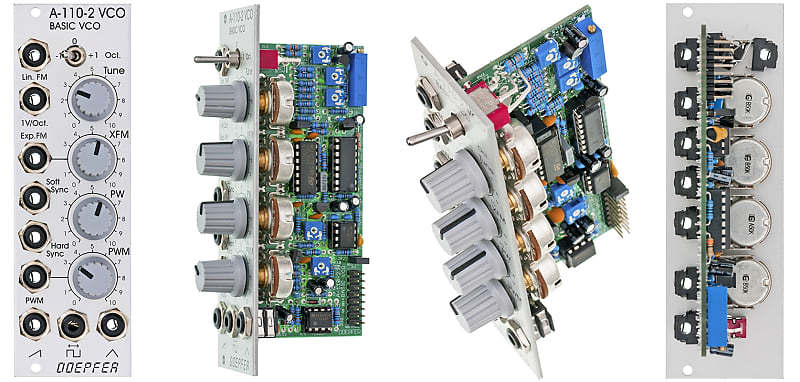
Doepfer A-110-2 VCO. - Standard
Price$149
Free Shipping
Free Shipping
from New Orleans, LA
Listed:over a month ago
Views:31
Watchers:1
Offers:0

New Orleans, LA, United States
30-Day Return Policy
Enjoy peace of mind with your new gear

Free Shipping
from New Orleans, LA

30-Day Return Policy
Enjoy peace of mind with your new gear
You are looking at the Doepfer A-110-2 VCO.
Module A-110-2 is a low-cost voltage-controlled oscillator. It's a slightly reduced version of the standard VCO A-110-2. Compared to the A-110-1 the A-110-2 has no sine output and the (expensive) octave rotary switch is replaced by a 3-position toggle switch. In return the A-110-2 is equipped with an additional linear FM input and a soft sync input. A jumper is used to select the range of the tune control between about 1/2 octave and about 4 octaves. The width of the module is only 8 HP compared to the 10 HP of the A-110-1.
All other features are essentially the same as for the A-110-1.
Explanation of the jumpers and trimming potentiometers:
Technical remarks:
The core of the A-110-2 is - like the A-101-1 a sawtooth oscillator (in contrast to the A-111-2, which is based on a triangle oscillator). The other waveforms are derived from the sawtooth by waveform converters. As the sawtooth reset (i.e., the back-to-zero slope) is not infinitely fast but takes a little bit of time the triangle is not perfect ! At the bottom of the waveform, it has a small glitch or notch that is caused by the sawtooth reset and cannot be eliminated by the waveform converter. If a perfect triangle is required the A-111-1 or *A-111-3 are recommended.
The sawtooth output of the A-110-2 has a falling (or negative ) slope. The front panel shows erroneously a rising (or positive) slope. This has no influence on the sound but becomes important when the module is used as an LFO or is mixed with the sawtooth output of another VCO.
The control voltage applied to the socket 1V/Oct is added to the control voltage coming from the bus (interruptible by removing the jumper JP2). Connecting a cable to the socket 1V/Oct does not interrupt the bus CV connection!To obtain also a sine signal the triangle-to-sine converter moduleA-184-2 is recommended. It includes also a voltage controlled crossfader to fade between two waveforms.
| Condition | |
| Brand | |
| Model |
|
| Finish |
|
| Categories | |
| Made In |
|
| Synth Module Function |
|
| Horizontal Pitch |
|
| Polyphony |
|
| Modular Synth Format |
|

You are looking at the Doepfer A-110-2 VCO.
Module A-110-2 is a low-cost voltage-controlled oscillator. It's a slightly reduced version of the standard VCO A-110-2. Compared to the A-110-1 the A-110-2 has no sine output and the (expensive) octave rotary switch is replaced by a 3-position toggle switch. In return the A-110-2 is equipped with an additional linear FM input and a soft sync input. A jumper is used to select the range of the tune control between about 1/2 octave and about 4 octaves. The width of the module is only 8 HP compared to the 10 HP of the A-110-1.
All other features are essentially the same as for the A-110-1.
Explanation of the jumpers and trimming potentiometers:
Technical remarks:
The core of the A-110-2 is - like the A-101-1 a sawtooth oscillator (in contrast to the A-111-2, which is based on a triangle oscillator). The other waveforms are derived from the sawtooth by waveform converters. As the sawtooth reset (i.e., the back-to-zero slope) is not infinitely fast but takes a little bit of time the triangle is not perfect ! At the bottom of the waveform, it has a small glitch or notch that is caused by the sawtooth reset and cannot be eliminated by the waveform converter. If a perfect triangle is required the A-111-1 or *A-111-3 are recommended.
The sawtooth output of the A-110-2 has a falling (or negative ) slope. The front panel shows erroneously a rising (or positive) slope. This has no influence on the sound but becomes important when the module is used as an LFO or is mixed with the sawtooth output of another VCO.
The control voltage applied to the socket 1V/Oct is added to the control voltage coming from the bus (interruptible by removing the jumper JP2). Connecting a cable to the socket 1V/Oct does not interrupt the bus CV connection!To obtain also a sine signal the triangle-to-sine converter moduleA-184-2 is recommended. It includes also a voltage controlled crossfader to fade between two waveforms.
| Condition | |
| Brand | |
| Model |
|
| Finish |
|
| Categories | |
| Made In |
|
| Synth Module Function |
|
| Horizontal Pitch |
|
| Polyphony |
|
| Modular Synth Format |
|
Your purchases help youth music programs get the gear they need to make music.
Your purchases also help protect forests, including trees traditionally used to make instruments.